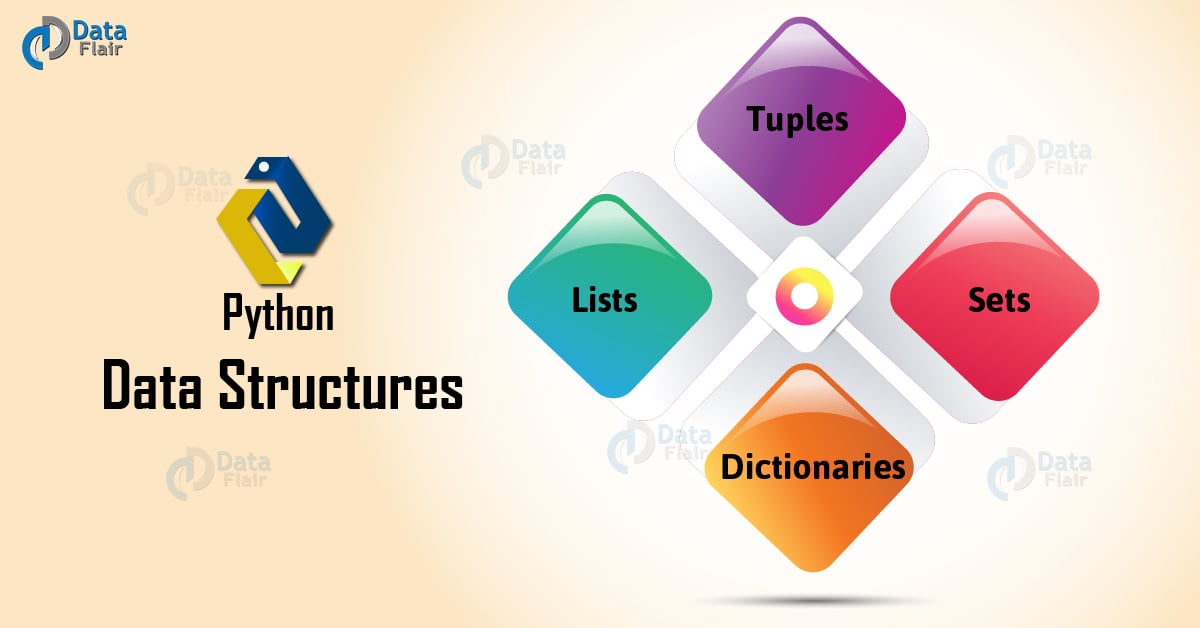Python Data Structures – Lists, Tuples, Sets, Dictionaries
Python course with 57 real-time projects - Learn Python
Earlier we have discussed Python Operators. Today, in this Python Data Structures Tutorial, we will talk about different data structures that Python provides us with.
These include Python list, Python tuple, Python set, and Python dictionaries with their syntax and examples.
So, let’s start Python Data Structure.
What is Python Data Structures?
You can think of a data structure as a way of organizing and storing data such that we can access and modify it efficiently.
Earlier, we have seen primitive data types like integers, floats, Booleans, and strings. Now, we’ll take a deeper look at the non-primitive Python data structures.
Let’s begin with our first Python Data Structures and lists.
What is Python List?
A list in Python is a heterogeneous container for items. This would remind you of an array in C++, but since Python does not support arrays, we have Python Lists.
1. How to Declare Python List?
To use a list, you must declare it first. Do this using square brackets and separate values with commas.
>>> languages=['C++','Python','Scratch']
Technology is evolving rapidly!
Stay updated with DataFlair on WhatsApp!!
You can put any kind of value in a list. This can be a string, a Tuple, a Boolean, or even a list itself.
>>> list1=[1,[2,3],(4,5),False,'No']
Note that here, we put different kinds of values in the list. Hence, a list is (or can be) heterogeneous.
2. How to Access Python List?
a. Accessing an entire list
To access an entire list, all you need to do is to type its name in the shell.
>>> list1
Output
b. Accessing a single item from the list
To get just one item from the list, you must use its index. However, remember that indexing begins at 0. Let’s first take a look at the two kinds of indexing.
- Positive Indexing– As you can guess, positive indexing begins at 0 for the leftmost/first item, and then traverses right.
>>> list1[3]
Output
- Negative Indexing– Contrary to positive indexing, negative indexing begins at -1 for the rightmost/last item, and then traverses left. To get the same item form list1 by negative indexing, we use the index -2.
>>> type(list1[-2])
Output
It is also worth noting that the index can’t be a float, it has to be an integer.
>>> list1[1.0]
Output
Traceback (most recent call last):File “<pyshell#219>”, line 1, in <module>list1[1.0]
TypeError: list indices must be integers or slices, not float
If you face any doubt in a Python list or Python Data Structure, please comment.
3. Slicing a Python List
Sometimes, you may not want an entire list or a single item, but a number of items from it. Here, the slicing operator [:] comes into play.
Suppose we want items second through fourth from list ‘list1’. We write the following code for this.
>>> list1[1:4]
Output
Here, we wanted the items from [2,3] to False. The indices for these boundary items are 1 and 3 respectively. But if the ending index is n, then it prints items till index n-1. Hence, we gave it an ending index of 4 here.
We can use negative indexing in the slicing operator too. Let’s see how.
>>> list1[:-2]
Output
Here, -2 is the index for the tuple (4,5).
4. A list is mutable
Mutability is the ability to be mutated, to be changed. A list is mutable, so it is possible to reassign and delete individual items as well.
>>> languages
Output
>>> languages[2]='Java' >>> languages
Output
Of how to delete an item, we will see in section d.
5. How to Delete a Python List?
Like anything else in Python, it is possible to delete a list.
To delete an entire list, use the del keyword with the name of the list.
>>> list1
Output
Traceback (most recent call last):File “<pyshell#225>”, line 1, in <module>list1
NameError: name ‘list1’ is not defined
But to delete a single item or a slice, you need its index/indices.
>>> del languages[2] >>> languages
Output
Let’s delete a slice now.
>>> del languages[1:] >>> languages
Output
6. Reassigning a List in Python
You can either reassign a single item, a slice, or an entire list. Let’s take a new list and then reassign on it.
>>> list1=[1,2,3,4,5,6,7,8]
a. Reassigning a single item
>>> list1[0]=0 >>> list1
Output
b. Reassigning a slice
Now let’s attempt reassigning a slice.
>>> list1[1:3]=[9,10,11] >>> list1
Output
c. Reassigning the entire list
Finally, let’s reassign the entire list.
>>> list1=[0,0,0] >>> list1
Output
To get an even deeper look into lists, read our article on Python Lists.
Any query yet on Python Data structures, Please Comment
Python Tuple
This Python Data Structure is like a, like a list in Python, is a heterogeneous container for items.
But the major difference between the two (tuple and list) is that a list is mutable, but a tuple is immutable.
This means that while you can reassign or delete an entire tuple, you cannot do the same to a single item or a slice.
To declare a tuple, we use parentheses.
>>> colors=('Red','Green','Blue')1. Python Tuple Packing
Python Tuple packing is the term for packing a sequence of values into a tuple without using parentheses.
>>> mytuple=1,2,3, #Or it could have been mytuple=1,2,3 >>> mytuple
Output
2. Python Tuple Unpacking
The opposite of tuple packing, unpacking allots the values from a tuple into a sequence of variables.
>>> a,b,c=mytuple >>> print(a,b,c)
Output
3. Creating a tuple with a single item
Let’s do this once again. Create a tuple and assign a 1 to it.
>>> a=(1)
Now, let’s call the type() function on it.
>>> type(a)
Output
As you can see, this declared an integer, not a tuple.
To get around this, you need to append a comma to the end of the first item 1. This tells the interpreter that it’s a tuple.
>>> a=(1,) >>> type(a)
Output
4. Accessing, Reassigning, and Deleting Items
We can perform these operations on a tuple just like we can on a list. The only differences that exist are because a tuple is immutable, so you can’t mess with a single item or a slice.
>>> del a[0]
Output
Traceback (most recent call last):File “<pyshell#251>”, line 1, in <module>del a[0]
TypeError: ‘tuple’ object doesn’t support item deletion
Even though this tuple has only one item, we couldn’t delete it because we used its index to delete.
Python Set
This is one of the important Python Data Structures. A Python set is a slightly different concept from a list or a tuple. A set, in Python, is just like the mathematical set. It does not hold duplicate values and is unordered. However, it is not immutable, unlike a tuple.
Let’s first declare a set. Use curly braces for the same.
>>> myset={3,1,2}
>>> myset
Output
As you can see, it rearranged the elements in an ascending order.
Since a set is unordered, there is no way we can use indexing to access or delete its elements. Then, to perform operations on it, Python provides us with a list of functions and methods like discard(), pop(), clear(), remove(), add(), and more. Functions like len() and max() also apply on sets.
Any Doubt yet in Python Data Structures? Please Comment.
Python Dictionaries
Finally, we will take a look at Python dictionaries. Think of a real-life dictionary. What is it used for? It holds word-meaning pairs. Likewise, a Python dictionary holds key-value pairs. However, you may not use an unhashable item as a key.
To declare a Python dictionary, we use curly braces. But since it has key-value pairs instead of single values, this differentiates a dictionary from a set.
>>> mydict={1:2,2:4,3:6}
>>> mydictOutput
To access pairs from a Python dictionary, we use their keys as indices. For example, let’s try accessing the value 4.
>>> mydict[2]
Output
This was all about the Python Data Structures Tutorial.
Python Interview Questions on Data Structures
- Is Python good for data structures?
- What are the different types of data structures in Python?
- What is Python Data Structure? Explain with example.
- What is set data structure in Python?
- What data structure is Python list?
Conclusion
Summing up for today’s Python Data Structures tutorial, we learned about various user-defined data structures using python like lists, tuples, sets, and dictionaries.
All of these have their own advantages and disadvantages. It is highly recommended to refer to our tutorials on each of those to sharpen your axes. See you later.
You give me 15 seconds I promise you best tutorials
Please share your happy experience on Google



Your step by step coverage on topics is really helpful. Thanks for creating this stuff.
We are glad that our readers are liking DataFlair articles. Keep visiting the DataFlair website for more such learnings.
in set its immutable
Hello Raj, yes a set is mutable and a frozenset is immutable in Python.
e. Reassigning a List in Python –> 2. Reassigning a slice -> list1[1:3]=[9,10,11]
Isn’t it “list1[1:4]=[9,10,11]” ??
Hello Sruthi,
We reassign the slice list1[1:3] with this list [9,10,11]. So it scrapes the elements 2 and 3, and puts 9, 10, and 11 in their place. They don’t have to be the same size.
Hope, it helps!
it was very beneficial for me …thx
Thanks for liking the Python data structures tutorial. Keep visiting DataFlair for more such tutorials.
Can u please tell me …….in sets key for dictionary is possible or impossible? In lists it is not possible and for tuple it is possible when only immutable elements are stored then what about set?
set does not hold duplicate values and is unordered. So you can store the keys of ductionary in a set beacuse keys are also unique.
I only have one question…why?
What was wrong with just one. Why do we need all 4? What are the advantages of each one that make them useful…
All the best,
Anna L.
“Hi Anna
Could you please provide a clear and concise explanation of what you are unsure about?”
your explanation in python is perfect but will like to learn more .how can i get your tutorial .
Please, you can reach me through my email.
After completing this course, I am sure that I will be in a position to call myself software developer, because this course has all it takes to master Python Language.